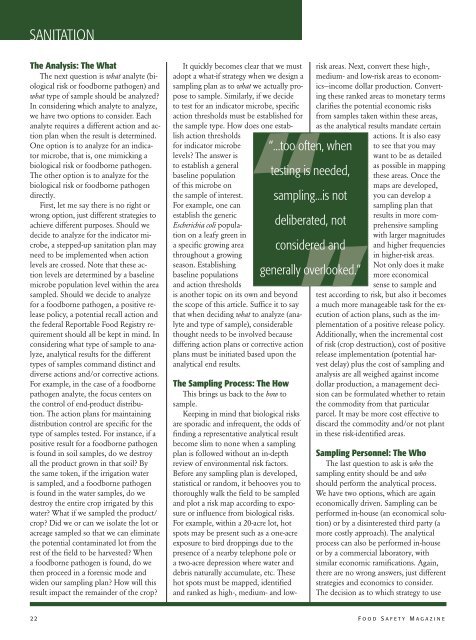Food Safety Magazine, February/March 2013
Food Safety Magazine, February/March 2013
Food Safety Magazine, February/March 2013
You also want an ePaper? Increase the reach of your titles
YUMPU automatically turns print PDFs into web optimized ePapers that Google loves.
SANITATIONThe Analysis: The WhatThe next question is what analyte (biologicalrisk or foodborne pathogen) andwhat type of sample should be analyzed?In considering which analyte to analyze,we have two options to consider. Eachanalyte requires a different action and actionplan when the result is determined.One option is to analyze for an indicatormicrobe, that is, one mimicking abiological risk or foodborne pathogen.The other option is to analyze for thebiological risk or foodborne pathogendirectly.First, let me say there is no right orwrong option, just different strategies toachieve different purposes. Should wedecide to analyze for the indicator microbe,a stepped-up sanitation plan mayneed to be implemented when actionlevels are crossed. Note that these actionlevels are determined by a baselinemicrobe population level within the areasampled. Should we decide to analyzefor a foodborne pathogen, a positive releasepolicy, a potential recall action andthe federal Reportable <strong>Food</strong> Registry requirementshould all be kept in mind. Inconsidering what type of sample to analyze,analytical results for the differenttypes of samples command distinct anddiverse actions and/or corrective actions.For example, in the case of a foodbornepathogen analyte, the focus centers onthe control of end-product distribution.The action plans for maintainingdistribution control are specific for thetype of samples tested. For instance, if apositive result for a foodborne pathogenis found in soil samples, do we destroyall the product grown in that soil? Bythe same token, if the irrigation wateris sampled, and a foodborne pathogenis found in the water samples, do wedestroy the entire crop irrigated by thiswater? What if we sampled the product/crop? Did we or can we isolate the lot oracreage sampled so that we can eliminatethe potential contaminated lot from therest of the field to be harvested? Whena foodborne pathogen is found, do wethen proceed in a forensic mode andwiden our sampling plan? How will thisresult impact the remainder of the crop?It quickly becomes clear that we mustadopt a what-if strategy when we design asampling plan as to what we actually proposeto sample. Similarly, if we decideto test for an indicator microbe, specificaction thresholds must be established forthe sample type. How does one establishaction thresholdsfor indicator microbelevels? The answer isto establish a generalbaseline populationof this microbe onthe sample of interest.For example, one canestablish the genericEscherichia coli populationon a leafy green ina specific growing areathroughout a growingseason. Establishingbaseline populationsand action thresholdsis another topic on its own and beyondthe scope of this article. Suffice it to saythat when deciding what to analyze (analyteand type of sample), considerablethought needs to be involved becausediffering action plans or corrective actionplans must be initiated based upon theanalytical end results.“...too often, whentesting is needed,sampling...is notdeliberated, notconsidered andgenerally overlooked.”The Sampling Process: The HowThis brings us back to the how tosample.Keeping in mind that biological risksare sporadic and infrequent, the odds offinding a representative analytical resultbecome slim to none when a samplingplan is followed without an in-depthreview of environmental risk factors.Before any sampling plan is developed,statistical or random, it behooves you tothoroughly walk the field to be sampledand plot a risk map according to exposureor influence from biological risks.For example, within a 20-acre lot, hotspots may be present such as a one-acreexposure to bird droppings due to thepresence of a nearby telephone pole ora two-acre depression where water anddebris naturally accumulate, etc. Thesehot spots must be mapped, identifiedand ranked as high-, medium- and lowriskareas. Next, convert these high-,medium- and low-risk areas to economics—incomedollar production. Convertingthese ranked areas to monetary termsclarifies the potential economic risksfrom samples taken within these areas,as the analytical results mandate certainactions. It is also easyto see that you maywant to be as detailedas possible in mappingthese areas. Once themaps are developed,you can develop asampling plan thatresults in more comprehensivesamplingwith larger magnitudesand higher frequenciesin higher-risk areas.Not only does it makemore economicalsense to sample andtest according to risk, but also it becomesa much more manageable task for the executionof action plans, such as the implementationof a positive release policy.Additionally, when the incremental costof risk (crop destruction), cost of positiverelease implementation (potential harvestdelay) plus the cost of sampling andanalysis are all weighed against incomedollar production, a management decisioncan be formulated whether to retainthe commodity from that particularparcel. It may be more cost effective todiscard the commodity and/or not plantin these risk-identified areas.Sampling Personnel: The WhoThe last question to ask is who thesampling entity should be and whoshould perform the analytical process.We have two options, which are againeconomically driven. Sampling can beperformed in-house (an economical solution)or by a disinterested third party (amore costly approach). The analyticalprocess can also be performed in-houseor by a commercial laboratory, withsimilar economic ramifications. Again,there are no wrong answers, just differentstrategies and economics to consider.The decision as to which strategy to use22 F o o d S a f e t y M a g a z i n e






![Otomatik indirilmez ise tıklayınız [Download]](https://img.yumpu.com/44170525/1/190x190/otomatik-indirilmez-ise-taklayanaz-download.jpg?quality=85)









